How to see what Shopify apps a store is using
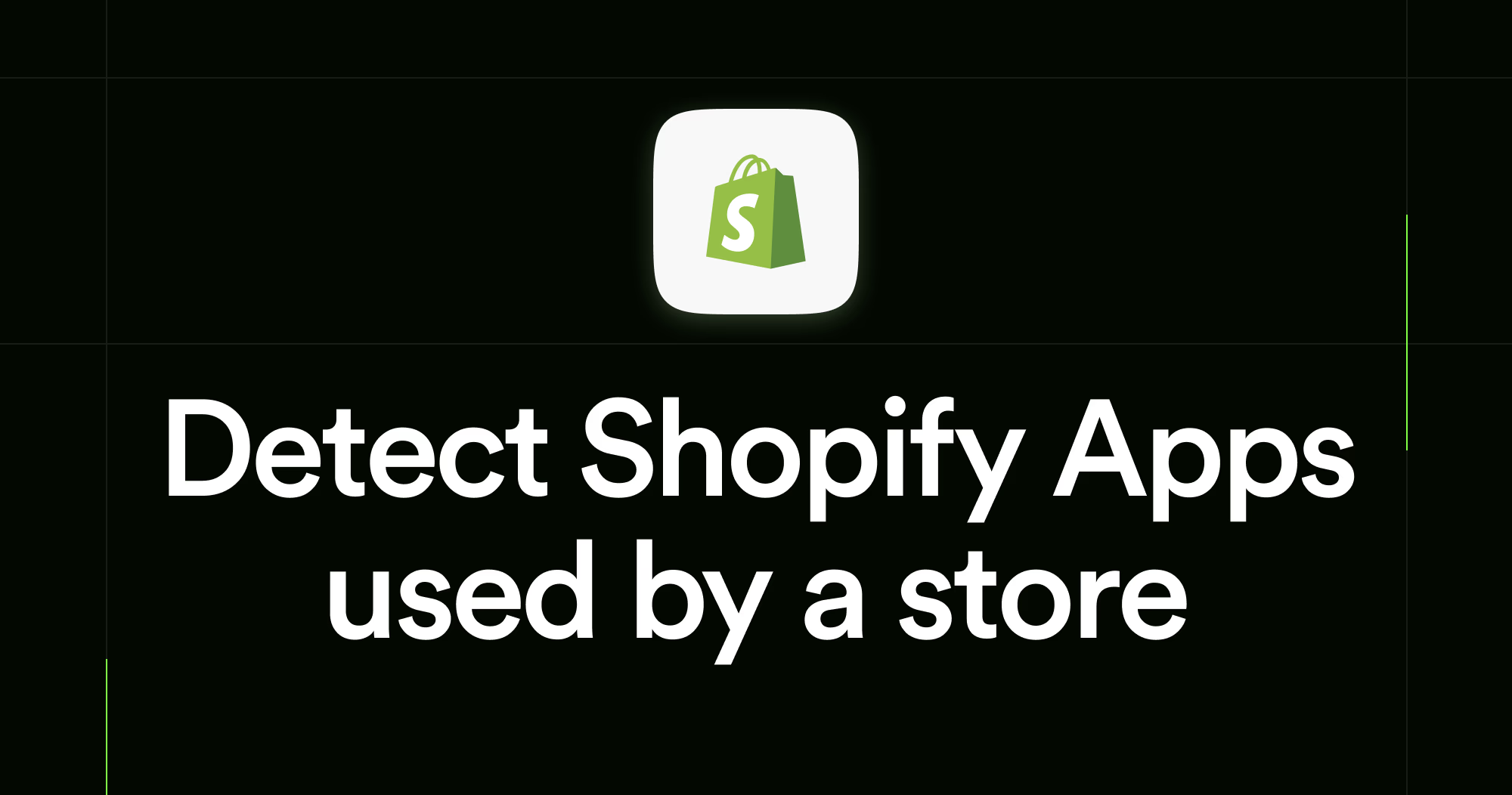
Ever wondered what secret apps power your favorite Shopify stores? Maybe you've spotted a competitor with an amazing product filter or a slick checkout process, and you're dying to know how they built it.
The good news is that it's easier than you think to peek behind the curtain. With the right tools and techniques, you can identify almost every app running on any Shopify store in just a few minutes. This complete guide will show you exactly how to do it, from simple browser extensions to advanced manual inspection techniques.
Why Identify Shopify Apps?
Understanding what apps other stores use isn't just curiosity—it's smart business strategy that can give you a competitive edge.
Competitor research helps you see what tools successful stores in your niche rely on. If three top competitors all use the same review app, that's probably worth investigating for your own store.
Finding inspiration becomes easier when you can discover apps you didn't know existed. Maybe you'll find a new way to handle returns, a clever upselling strategy, or an innovative customer service solution that could transform your business.
Research partners more effectively by knowing their tech stack, which helps you understand their needs and approach when reaching out to potential partners or influencers.
Hire better developers by knowing which apps a store uses, helping you find someone with the right experience for your specific requirements.
Quick Answer (1-Minute Overview)
The fastest way: Install TrendTrack's Chrome extension → visit any Shopify store → click the extension icon → get results in seconds.
For deeper analysis: Use manual code inspection or combine multiple tools for maximum accuracy.
Best overall approach: Start with TrendTrack for quick wins, then use manual methods to catch apps that automated tools miss.
For the quickest results, use Trendtrack's Browser Extension. It scans a Shopify store and lists detected apps in seconds without needing any technical skills.
How Shopify Apps Integrate with Stores
To understand detection methods, you need to know how apps actually integrate with Shopify stores. When a store installs an app, it typically leaves digital traces in several places throughout the website's code and structure.
These traces include JavaScript files that make app features work, CSS stylesheets for custom styling, HTML markup changes, network requests to external servers, and meta tags in page headers. The more traces an app leaves, the easier it becomes to spot using detection tools.
Method 1: Using Browser Extensions
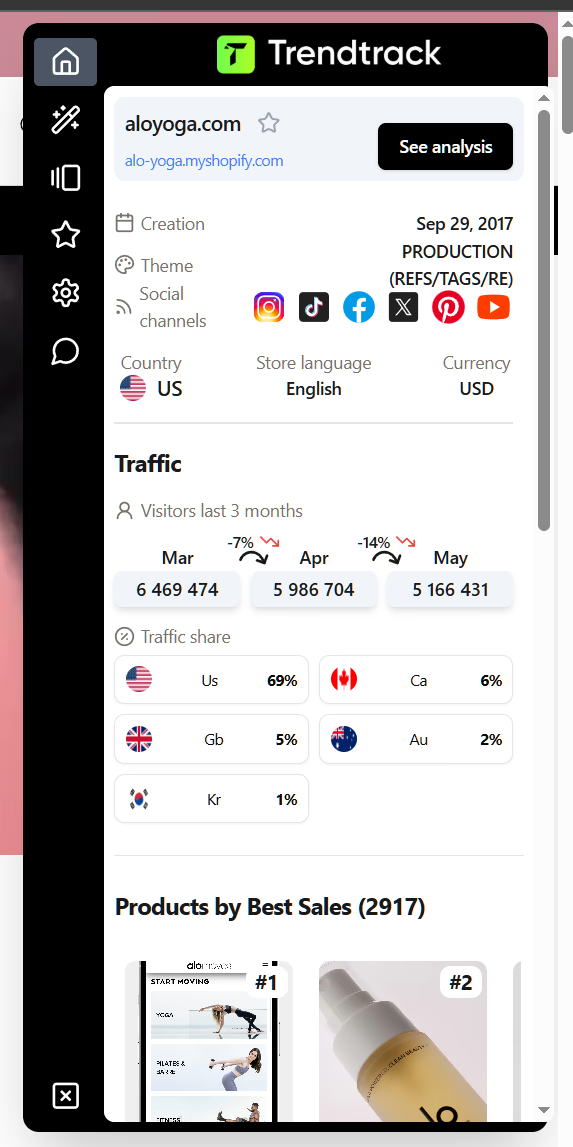
Browser extensions are the fastest and most user-friendly option for detecting Shopify apps. They automatically scan pages and show you results in a clean, organized interface without requiring any technical knowledge.
TrendTrack Chrome Extension
TrendTrack is built specifically for Shopify app detection, making it one of the most accurate tools available. The extension updates its database regularly and focuses exclusively on Shopify apps rather than general web technologies.
Step-by-step walkthrough:
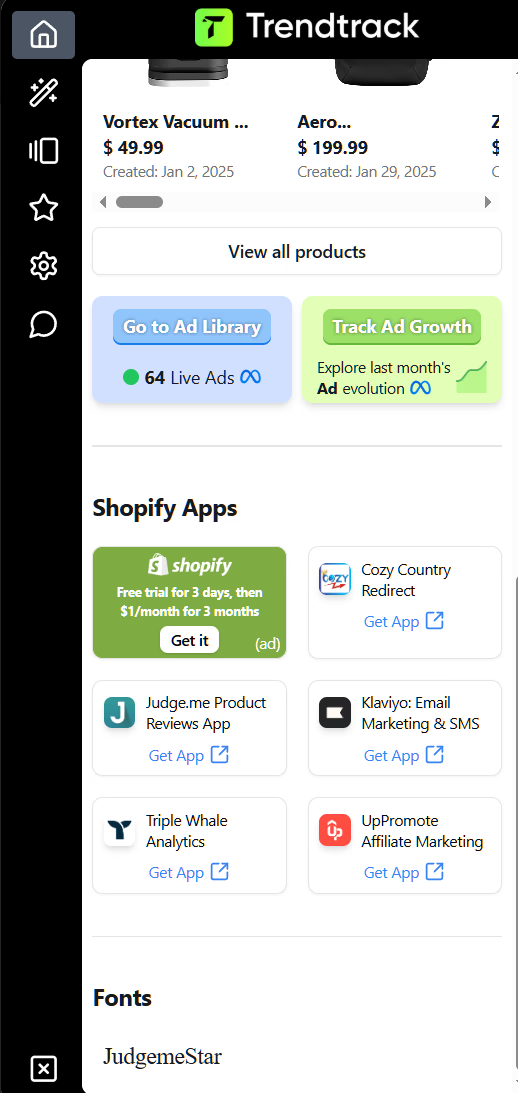
- Install the TrendTrack extension from the Chrome Web Store
- Visit any Shopify store you want to analyze
- Click the TrendTrack icon in your browser toolbar
- Wait 2-3 seconds for the scan to complete
- Browse the results, which are organized by app category for easy understanding
What makes TrendTrack special:
- Shopify-focused detection engine that understands the platform's unique architecture
- Shows app pricing, ratings, and detailed information
- Identifies both free and paid apps accurately
- Works on mobile browsers for on-the-go research
Limitations to keep in mind:
- Currently Chrome only (no Firefox version available yet)
- Can't detect backend-only apps that don't modify the storefront
- Occasionally misses brand-new apps that haven't been added to the database yet
Install Our Free Chrome Extension
Analyze any Shopify store you visit with our powerful browser extension. Get instant insights on traffic sources, visitor volume, themes, and apps.
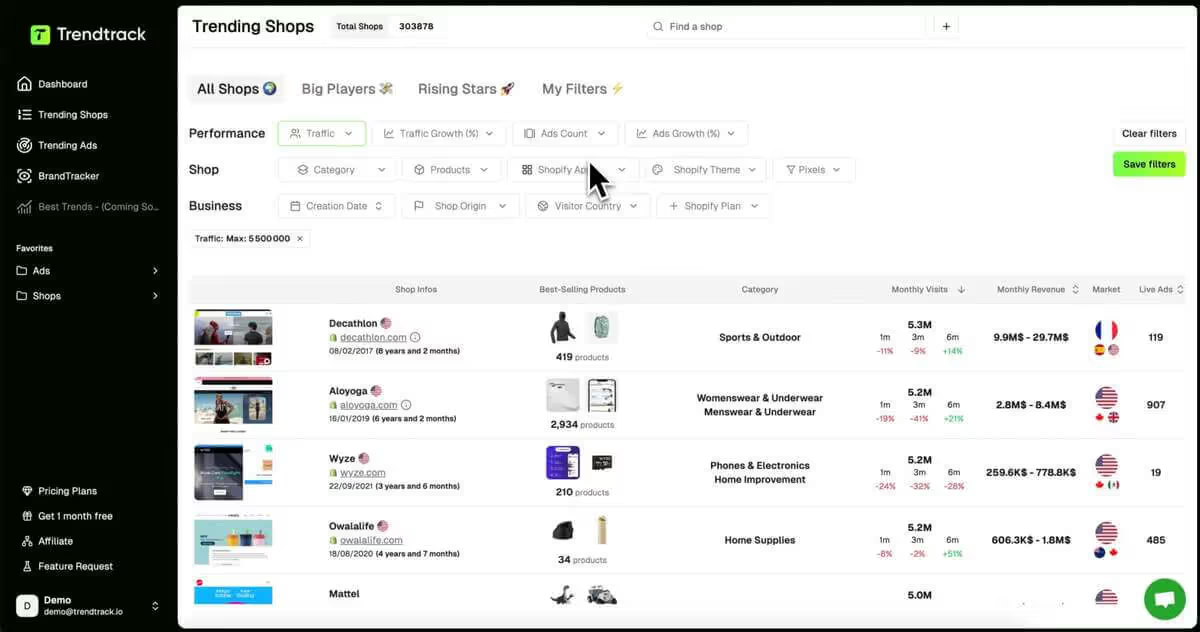
BuiltWith and Wappalyzer
These are general website technology detectors that also catch Shopify apps, though they're not as specialized as TrendTrack.
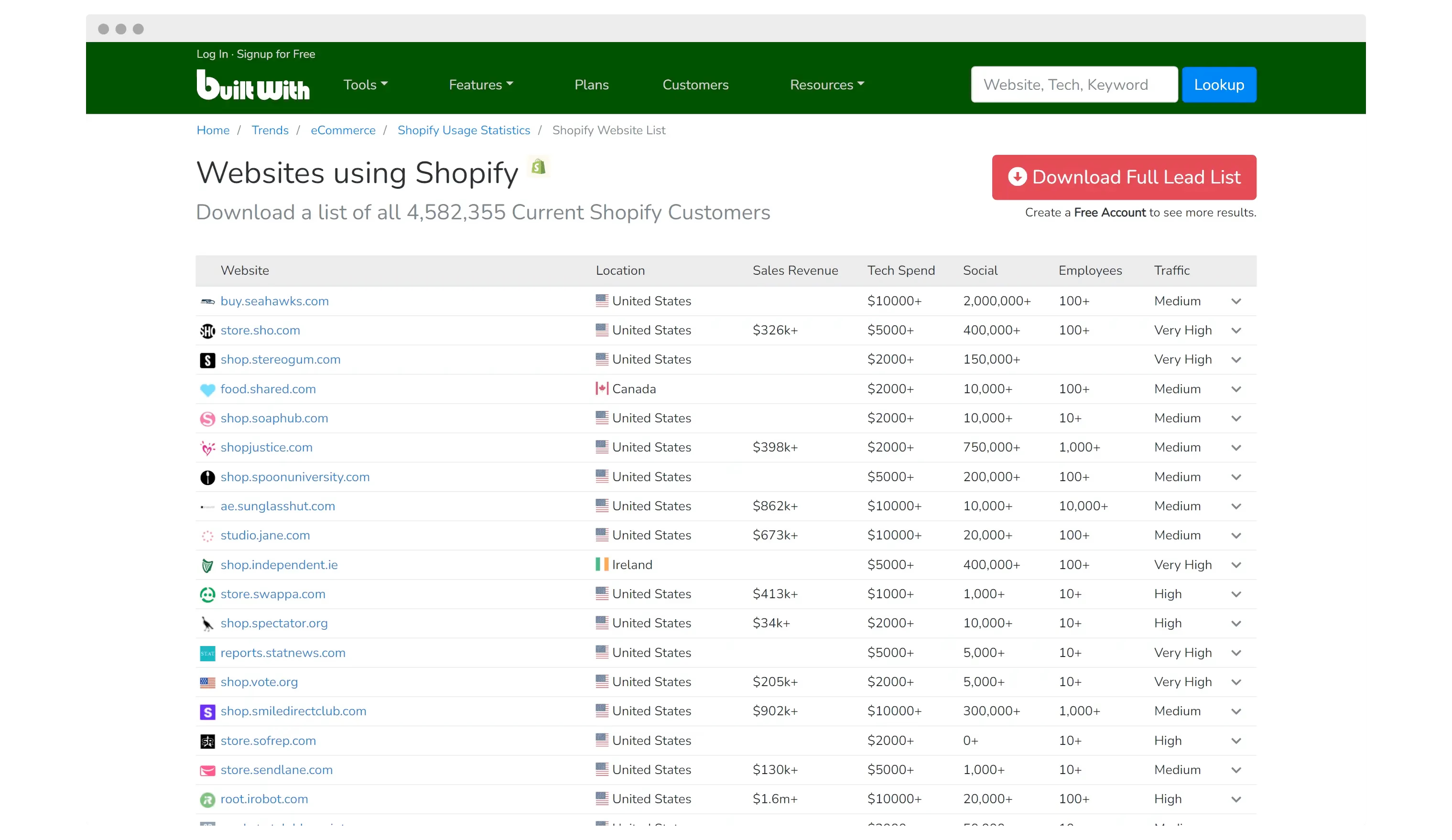
BuiltWith provides detailed technology profiles but focuses more on general web technologies than Shopify-specific apps. It's excellent for identifying themes, payment processors, and major platforms, plus it offers historical data showing how a site's technology stack has evolved over time.
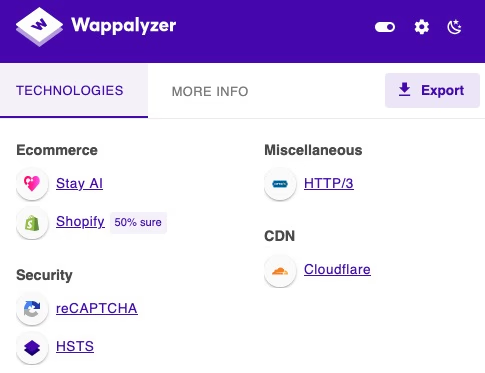
Wappalyzer offers a similar service but with a cleaner interface. It categorizes technologies and shows confidence levels for each detection, making it easier to understand how certain the tool is about each finding.
Both tools work well for general technology detection, but they're not as specialized as TrendTrack for Shopify apps specifically.
Koala Inspector
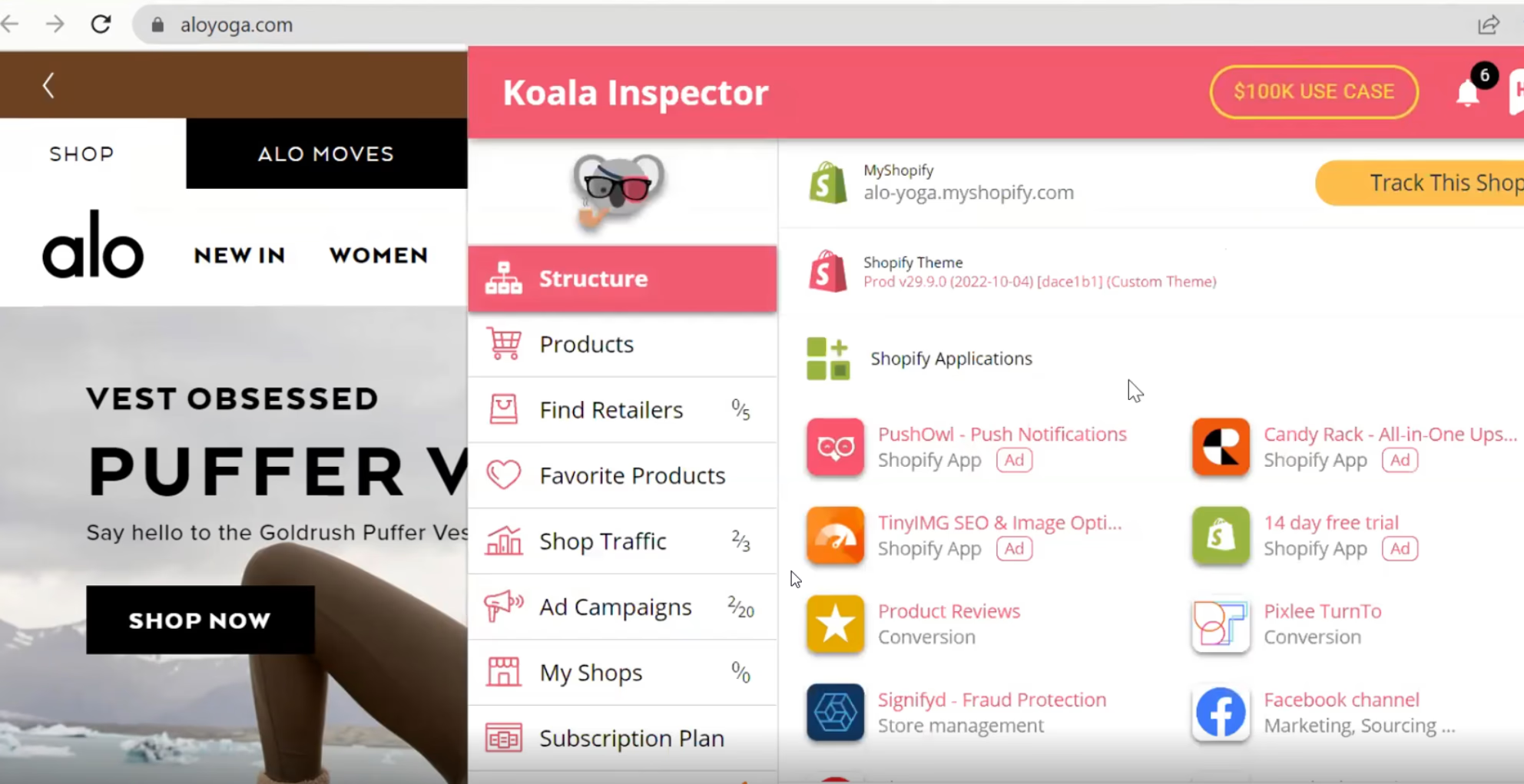
Popular among Shopify store owners, Koala Inspector shows apps, themes, and other technologies in a simple interface. While it has decent accuracy for common apps, it's less comprehensive than TrendTrack.
Pros:
- Free version available for basic detection
- Shows theme information alongside app detection
- Works on most Shopify stores without issues
Cons:
- Less accurate than TrendTrack for app detection
- Limited database of newer or niche apps
- Can be slow on complex stores with many apps
Method 2: Manual Code Inspection
If you're comfortable with code, manual inspection often reveals apps that automated tools miss. This method requires more technical knowledge but gives you complete control over the detection process.
Checking JavaScript Files
Right-click on any Shopify store page and select "View Page Source." Look for JavaScript files that hint at specific apps:
<!-- Klaviyo email marketing -->
<script src="https://static.klaviyo.com/onsite/js/klaviyo.js"></script>
<!-- Yotpo reviews -->
<script src="https://staticw2.yotpo.com/widget.js"></script>
<!-- Judge.me reviews -->
<script src="https://judgeme-widget.s3.amazonaws.com/widget.js"></script>Network Tab Investigation
Open Chrome DevTools (F12), go to the Network tab, and refresh the page. Look for requests to external domains, as these often indicate third-party apps:
api.klaviyo.comsuggests Klaviyo email marketingwidget.reviewscouk.comindicates Reviews.co.ukapi.smile.iomeans Smile loyalty program
CSS and HTML Clues
Some apps inject distinctive CSS classes or HTML elements that you can spot with careful inspection:
/* Privy popup app */
.privy-overlay, .privy-popup
/* Gorgias helpdesk */
.gorgias-chat-container
/* Loox reviews */
.loox-reviews-defaultManual inspection advantages:
- Finds apps that automated tools miss completely
- Gives you a deeper technical understanding of how apps work
- Works even when extensions are blocked or unavailable
Manual inspection disadvantages:
- Takes significant time and requires technical knowledge
- Easy to miss subtle clues if you're not experienced
- Requires familiarity with HTML, CSS, and JavaScript
Save Hours of Research Time
Stop checking five different tools. Trendtrack provides better insights in one platform. Save time and streamline your research workflow.

Method 3: Online Databases & SaaS Intelligence Tools
Professional researchers and sales teams often use specialized databases that track technology usage across millions of websites. These tools offer broader insights but may have limited Shopify app data.
LinkedIn Sales Navigator
While not specifically designed for app detection, Sales Navigator's company insights sometimes mention technologies and tools companies use. Search for the company behind a Shopify store and check their company page or employee profiles for technology mentions.
Apollo and Snov.io
These sales intelligence platforms maintain comprehensive technology databases. You can search for companies and see their estimated tech stack, though Shopify app data may be limited compared to general business software.
SimilarTech and Datanyze
Business intelligence platforms that track technology adoption across the web. They're more focused on enterprise software but occasionally capture Shopify app data, especially for larger stores.
Database tool advantages:
- Comprehensive company information beyond just apps
- Historical technology data showing changes over time
- Contact information for outreach and partnership opportunities
Database tool disadvantages:
- Often expensive with monthly subscription fees
- Shopify app data may be incomplete or outdated
- Better for general business technology than specific ecommerce apps
Comparison Table: Top Shopify App Detectors
With so many detection options available, choosing the right tool can feel overwhelming. This comparison breaks down the key factors to help you pick the method that best fits your needs, technical skill level, and budget.
Tool | Price | Accuracy | Ease of Use | Best For |
|---|---|---|---|---|
TrendTrack | Free/Premium | Very High | Excellent | Shopify-specific detection |
BuiltWith | Free/Premium | High | Good | General web tech + history |
Wappalyzer | Free/Premium | High | Excellent | Clean interface + confidence |
Koala Inspector | Free/Premium | Medium | Good | Theme + app detection |
Manual Inspection | Free | Highest | Difficult | Complete control |
Interpreting the Results & Actionable Next Steps
Once you've identified a store's apps, here's how to transform that information into actionable business insights.
Remember that identifying a competitor's apps is just the first step. The real advantage comes from understanding why they use those tools and developing your own strategy to serve your customers better.
Categorize by Function
Group apps into categories like marketing, customer service, analytics, and operations. This organization helps you understand the store's priorities and where they're investing their resources.
Research Each App Thoroughly
Don't just collect app names—understand what each one actually does for the business. Visit the Shopify App Store and read descriptions, reviews, and pricing information to get a complete picture.
Look for Patterns Across Competitors
If multiple successful competitors use the same app, that's a strong signal that it's worth considering for your own store. Pay special attention to apps that appear across different store sizes and niches.
Consider Your Context and Resources
An app that works well for a $10M store might be overkill for a startup. Consider your current size, budget, technical resources, and immediate needs before making decisions.
Want to streamline your research? Explore the Shopify Apps Detector tool for an easier way to uncover which public apps a store is using.
Limitations, Accuracy Issues, and Ethical Considerations
No detection method is 100% accurate, and it's important to understand these limitations before drawing conclusions.
What You Can Easily Detect:
- Apps that modify the storefront (reviews, popups, live chat)
- Apps with distinctive JavaScript files or CSS
- Popular apps included in detection databases
- Apps that make external API calls
What's Difficult to Detect:
- Backend-only apps (inventory management, accounting)
- Apps using generic code libraries
- Custom-built solutions or heavily modified apps
- Apps that are installed but not actively used
Be aware that no detection method, whether automated or manual, can identify backend-only apps like those for accounting or inventory management, as they don't leave traces on the storefront.
What's Impossible to Detect:
- Apps that leave no frontend traces whatsoever
- Internal tools and completely custom integrations
- Apps that have been discontinued but still run
- Apps hidden through advanced customization
Common Accuracy Issues
False Positives occur when tools identify apps that aren't actually installed. This happens when stores leave behind code from previously uninstalled apps.
False Negatives mean some apps are missed, especially newer ones or those with minimal frontend presence.
Version Confusion happens when tools detect an app but not its specific plan or version.
To improve accuracy, use multiple detection methods and cross-reference results from different tools.
Ethical Considerations
App detection uses publicly available information, but it's important to use this data responsibly and ethically.
Best practices:
- Use findings for inspiration and education, not copying
- Research apps thoroughly before implementing them yourself
- Focus on improving your own store rather than just copying others
- Respect competitors' strategies and innovations
Avoid these mistakes:
- Copying entire strategies without understanding them
- Sharing sensitive competitive information publicly
- Using findings to disparage or attack competitors
- Assuming every detected app is actively contributing to success
Bonus: 10 Most Common Shopify Apps and What They Do

Based on analysis of thousands of Shopify stores, these apps appear most frequently across successful ecommerce businesses:
- Google Analytics - Website analytics and visitor tracking
- Klaviyo - Email marketing automation and customer segmentation
- Judge.me - Product reviews and ratings collection
- Privy - Email popups and lead capture forms
- Yotpo - Reviews and user-generated content management
- Gorgias - Customer service and helpdesk integration
Understanding these popular apps gives you a baseline for what most successful stores consider essential infrastructure.
Curious which apps can actually level up your own store? Dive into our list of the best Shopify apps to increase sales for in-depth insights and recommendations.
Advanced Detection Tactics
Historical Analysis
Use tools like BuiltWith Pro to see how a store's app usage has changed over time. This reveals what they've experimented with and abandoned, giving you insights into what works and what doesn't.
Performance Impact Analysis
Combine app detection with performance testing using tools like GTmetrix to understand how different apps affect site speed and user experience.
Mobile Detection Workflow
Most detection methods work best on desktop browsers, but you can adapt them for mobile research:
- Use mobile versions of browser extensions where available
- Request the desktop site version for better code inspection
- Take screenshots on mobile and analyze them later on desktop
- Use mobile-friendly detection tools when possible
From Detection to Implementation
Identifying apps is just the beginning. Here's how to turn your discoveries into actual business improvements.
Test Before You Install
Don't install every app you discover on competitor sites. Research thoroughly, read recent reviews, and make sure each app addresses a specific need in your business.
Start Small and Scale Gradually
If a competitor uses 20 apps, don't try to install all 20 at once. Start with one or two apps that address your biggest pain points or opportunities.
Monitor Performance Impact
Track how new apps affect your site speed, conversion rates, and overall user experience. Some apps can slow down your site or create conflicts with existing functionality.
Budget Smart for Long-Term Success
App subscriptions add up quickly and can become a significant monthly expense. Factor ongoing costs into your decision-making process and regularly audit which apps are actually providing value.
Unlock Shopify Store Insights
Discover the exact themes, apps, and product strategies that successful stores are using to generate sales and grow their business.

Conclusion
Knowing what apps your competitors use gives you valuable insights into successful ecommerce strategies. Whether you choose TrendTrack's specialized extension, manual code inspection, or professional database tools, you now have everything you need to uncover any store's tech stack.
The key is remembering that apps are just tools—real success comes from understanding your customers and executing smart strategies. Use your findings as inspiration and starting points, not as complete blueprints to copy.
Start with TrendTrack if you want the easiest and most accurate Shopify app detection, then dig deeper with manual inspection as you get more comfortable with the process.




Are you ready to get the insights?
From viral trends to million-dollar stores — unlock the insights behind what sells, scales, and converts. All in one place.




.avif)

